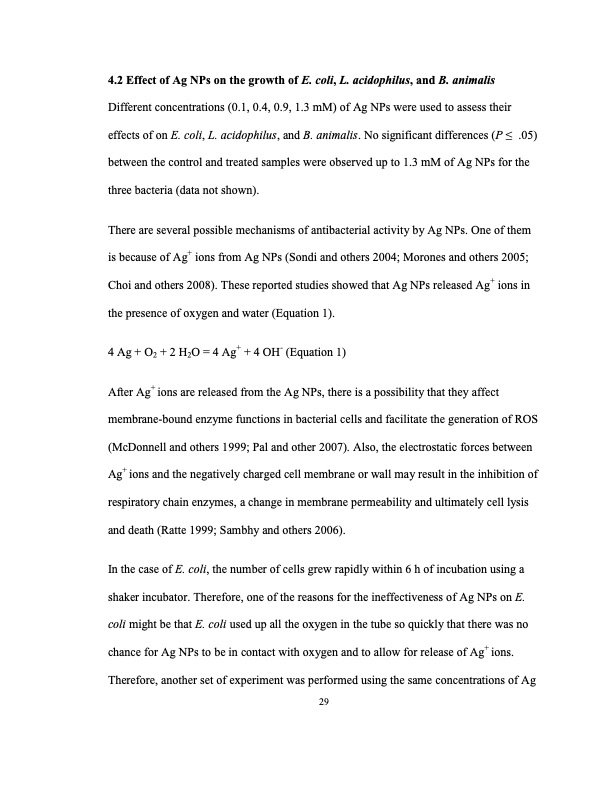
PDF Publication Title:
Text from PDF Page: 040
4.2 Effect of Ag NPs on the growth of E. coli, L. acidophilus, and B. animalis Different concentrations (0.1, 0.4, 0.9, 1.3 mM) of Ag NPs were used to assess their effects of on E. coli, L. acidophilus, and B. animalis. No significant differences (P ≤ .05) between the control and treated samples were observed up to 1.3 mM of Ag NPs for the three bacteria (data not shown). There are several possible mechanisms of antibacterial activity by Ag NPs. One of them is because of Ag+ ions from Ag NPs (Sondi and others 2004; Morones and others 2005; Choi and others 2008). These reported studies showed that Ag NPs released Ag+ ions in the presence of oxygen and water (Equation 1). 4 Ag + O2 + 2 H2O = 4 Ag+ + 4 OH- (Equation 1) After Ag+ ions are released from the Ag NPs, there is a possibility that they affect membrane-bound enzyme functions in bacterial cells and facilitate the generation of ROS (McDonnell and others 1999; Pal and other 2007). Also, the electrostatic forces between Ag+ ions and the negatively charged cell membrane or wall may result in the inhibition of respiratory chain enzymes, a change in membrane permeability and ultimately cell lysis and death (Ratte 1999; Sambhy and others 2006). In the case of E. coli, the number of cells grew rapidly within 6 h of incubation using a shaker incubator. Therefore, one of the reasons for the ineffectiveness of Ag NPs on E. coli might be that E. coli used up all the oxygen in the tube so quickly that there was no chance for Ag NPs to be in contact with oxygen and to allow for release of Ag+ ions. Therefore, another set of experiment was performed using the same concentrations of Ag 29PDF Image | ZINC OXIDE AND SILVER NANOPARTICLES ON INTESTINAL BACTERIA

PDF Search Title:
ZINC OXIDE AND SILVER NANOPARTICLES ON INTESTINAL BACTERIAOriginal File Name Searched:
thesis-zinc-oxide-silver-nano.pdfDIY PDF Search: Google It | Yahoo | Bing
Turbine and System Plans CAD CAM: Special for this month, any plans are $10,000 for complete Cad/Cam blueprints. License is for one build. Try before you buy a production license. More Info
Waste Heat Power Technology: Organic Rankine Cycle uses waste heat to make electricity, shaft horsepower and cooling. More Info
All Turbine and System Products: Infinity Turbine ORD systems, turbine generator sets, build plans and more to use your waste heat from 30C to 100C. More Info
CO2 Phase Change Demonstrator: CO2 goes supercritical at 30 C. This is a experimental platform which you can use to demonstrate phase change with low heat. Includes integration area for small CO2 turbine, static generator, and more. This can also be used for a GTL Gas to Liquids experimental platform. More Info
Introducing the Infinity Turbine Products Infinity Turbine develops and builds systems for making power from waste heat. It also is working on innovative strategies for storing, making, and deploying energy. More Info
Need Strategy? Use our Consulting and analyst services Infinity Turbine LLC is pleased to announce its consulting and analyst services. We have worked in the renewable energy industry as a researcher, developing sales and markets, along with may inventions and innovations. More Info
Made in USA with Global Energy Millennial Web Engine These pages were made with the Global Energy Web PDF Engine using Filemaker (Claris) software.
Infinity Turbine Developing Spinning Disc Reactor SDR or Spinning Disc Reactors reduce processing time for liquid production of Silver Nanoparticles.
| CONTACT TEL: 608-238-6001 Email: greg@infinityturbine.com | RSS | AMP |